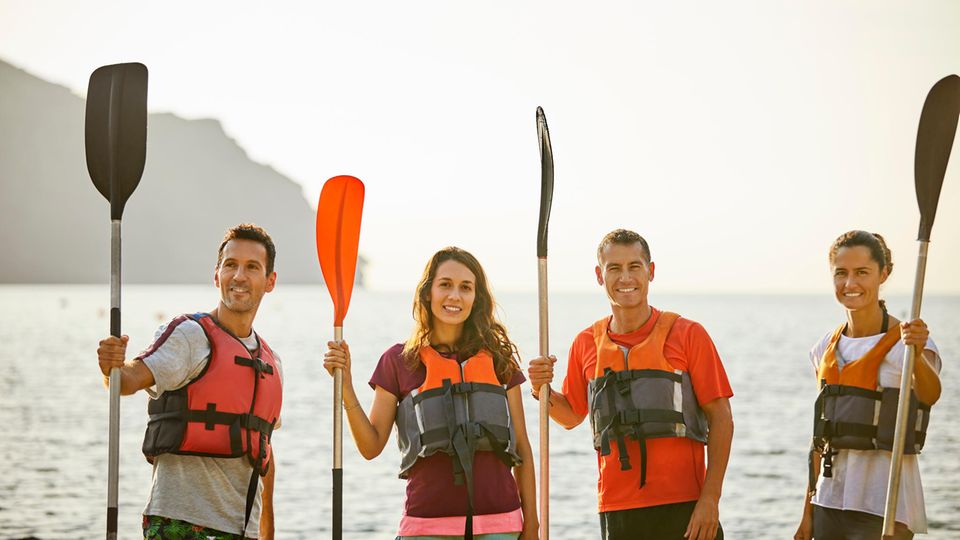Trend sport
Driving kayak: these are the most important basics and rules on the water
Surrounding rivers and lakes offer water sports enthusiasts the opportunity to explore the surrounding landscapes from the boat – for example with a kayak.
The kayak of Eskimos from Greenland was originally developed and served the hunt for the open sea. This also explains the narrow and elongated shape of the body: it should make the boat faster. Nowadays, kayak – at least in European realms – is only used as a means of transportation or sports equipment in their free time. Especially on sunny days you can see the agile boats in many places on the water, but less often the originals as a bubble kayaks. The advantages and disadvantages of the foldable models have to offer and what you should consider when driving kayak is explained here.
Inflatable kayaks: you need to know that
Derived from the Greenland word “Qajaq”, the kayak is also a canoe – i.e. a boat that is moved in the direction of travel using paddles. However, since the canoe is a generic term, other boat types such as the Canadian are also part of it. In contrast to the Canadian, the kayak is not open upwards, but all around (except for the seat hatch). Single or double seats are typical, but there are also larger models for . A double paddle is used to move in it: this is a paddle with two leaves.
Flared kayaks are suitable for cozy discovery tours through the surrounding towns, but can also be used as training equipment or fishing. The most important prerequisite is that you can swim – you should always keep an eye on the maximum load capacity. This applies not only to the number of people traveling, but also the total weight (including luggage). The equipment for most kayaks can be stowed away on the outside: there are small networks or cords where you are where you can attach.
Price vs. performance: that is the difference
The so -called hose kayaks are usually made from a polyester fabric that is coated with PVC or rubber. The boats are inflated using an air pump, which is already included in many providers. The air is pumped into the boat chambers provided for this purpose until enough pressure has been built up and the kayak has adopted a stable shape. In terms of price, the cheapest models are at short . There is even one -seater for . However, due to their rather thin boathy skin, these hose kayaks are only suitable for calm waters such as rivers and swimming lakes.
Even if you have to do a few compromises in terms of processing, quality and driving characteristics for the cheapest kayaks, you can do shorter paddle tours without any problems. For longer distances, on the other hand, you should rely on higher quality models that have higher operating pressure and more robust material. This makes them more stable – but also more expensive: here the hose kayaks are between 300 and 600 euros. The two -seater For example, costs around 700 euros. In addition, the paddle and the pump must also be ordered.
The advantages and disadvantages of inflatable kayaks
Advantages of hose kayaks:
- They are easier to transport
- You have a low weight
- You take less space
- You are cheaper to buy
Disadvantages of hose kayaks:
- They are more difficult to control
- They are slower than “real” kayaks
- You have less depth
- They are more susceptible to side and headwind
Drive a safe kayak: the right equipment
- You need the paddle to control and control the boat. It is usually included, but can also be bought individually. In any case, you need a paddle with two leaves – here you can switch to another model that has to be put together. This makes it easier to transport.
- For short distances on small rivers or swimming lakes, your ordinary bathing clothing is sufficient on warm days. If it rains, the wearing of waterproof clothing such as rain jackets and pants is recommended, since wetness deprives the body. For cold days and cool water is suitable .
- A helmet is usually not necessary on calm waters, but should be worn in any case if you take a whitewater trip with your kayak. Due to the strong currents as well as dangerous obstacles such as rocks and branches, you can injure yourself faster if you should capsize the boat.
- Children in particular should absolutely and always one Wear in the event that they capsize with the kayak. But wearing also makes sense for adults if, for example, they drive on waters with faster currents or on an open sea with kayak waves. You should always have one for security.
Tip: How to get in the kayak
It sounds so easy and yet the entry into kayak is not that easy – especially when the boat is already in the water. So that you can simply get into kayak from the shore, you should keep the boat straight with one hand and foot: first get into the kayak with one foot and balancing your balance until the boat no longer wobbles. Only then does the second foot come into the kayak, while you still hold on to the shore with one hand. And until you sat down safely. On the other hand, if you want to leave the hose kayak into the sea on the beach, you can simply put yourself on board in the flat water and then push the paddle into the deep water with the paddle. The paddle can be used as a support for every water, be it for the balance or as a kind of extended arm.
*This article contains so-called affiliate links to products in online shops. If a user clicks on it and buys something, the publisher receives a commission from the dealer, not from the manufacturer. Of course, where and when you buy a product is up to you.
Source: Stern
I am Pierce Boyd, a driven and ambitious professional working in the news industry. I have been writing for 24 Hours Worlds for over five years, specializing in sports section coverage. During my tenure at the publication, I have built an impressive portfolio of articles that has earned me a reputation as an experienced journalist and content creator.




